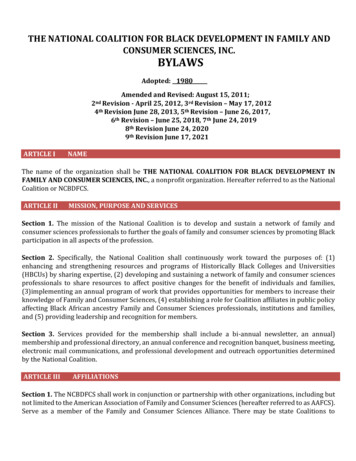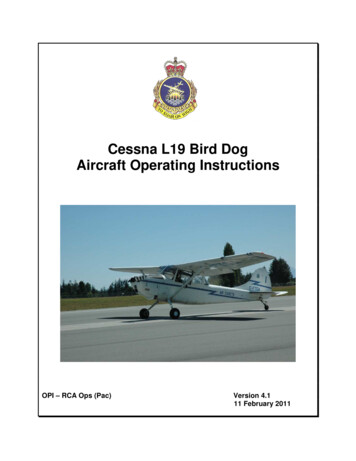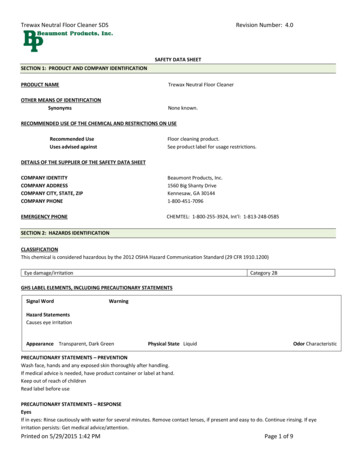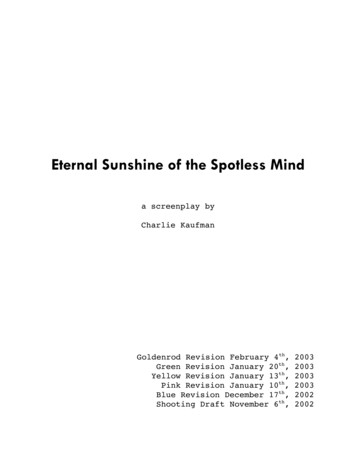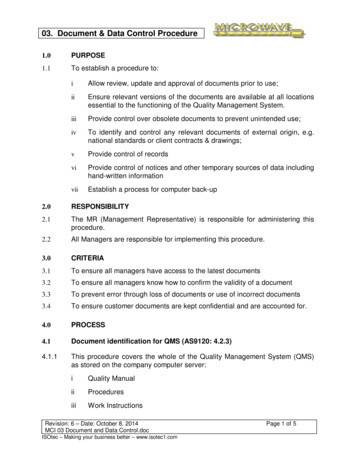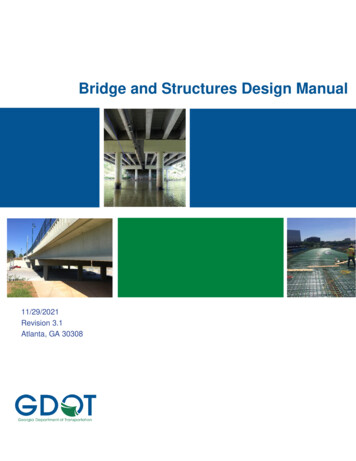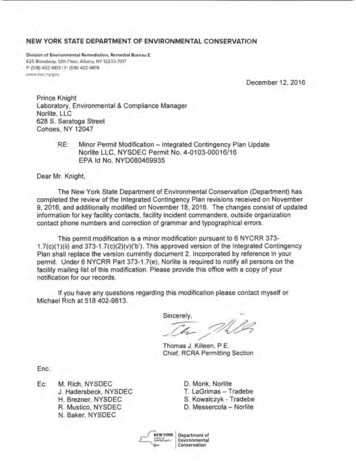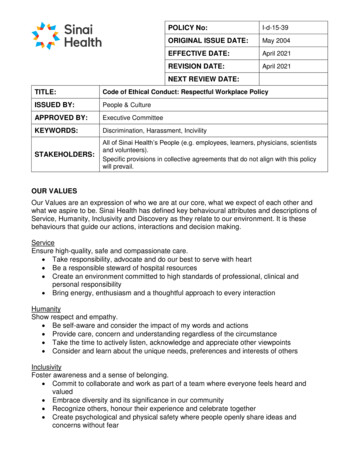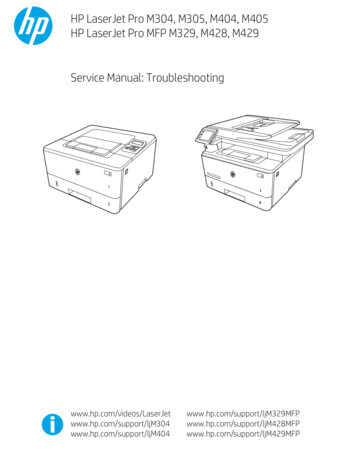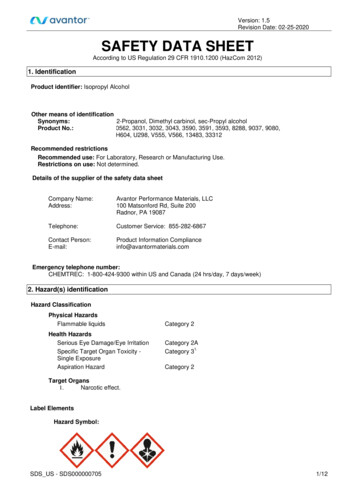
Transcription
Version: 1.5Revision Date: 02-25-2020SAFETY DATA SHEETAccording to US Regulation 29 CFR 1910.1200 (HazCom 2012)1. IdentificationProduct identifier: Isopropyl AlcoholOther means of identificationSynonyms:2-Propanol, Dimethyl carbinol, sec-Propyl alcoholProduct No.:0562, 3031, 3032, 3043, 3590, 3591, 3593, 8288, 9037, 9080,H604, U298, V555, V566, 13483, 33312Recommended restrictionsRecommended use: For Laboratory, Research or Manufacturing Use.Restrictions on use: Not determined.Details of the supplier of the safety data sheetCompany Name:Address:Avantor Performance Materials, LLC100 Matsonford Rd, Suite 200Radnor, PA 19087Telephone:Customer Service: 855-282-6867Contact Person:E-mail:Product Information Complianceinfo@avantormaterials.comEmergency telephone number:CHEMTREC: 1-800-424-9300 within US and Canada (24 hrs/day, 7 days/week)2. Hazard(s) identificationHazard ClassificationPhysical HazardsFlammable liquidsHealth HazardsSerious Eye Damage/Eye IrritationSpecific Target Organ Toxicity Single ExposureAspiration HazardCategory 2Category 2A1.Category 3Category 2Target Organs1.Narcotic effect.Label ElementsHazard Symbol:SDS US - SDS0000007051/12
Version: 1.5Revision Date: 02-25-2020Signal Word:DangerHazard Statement:Highly flammable liquid and vapor.Static accumulating flammable liquid can become electrostatically chargedeven in bonded and grounded equipment.Sparks may ignite liquid and vapor.May cause flash fire or explosion.Causes serious eye irritation.May cause drowsiness or dizziness.May be harmful if swallowed and enters airways.PrecautionaryStatementsPrevention:Keep away from heat, hot surfaces, sparks, open flames and other ignitionsources. No smoking. Keep container tightly closed. Ground and bondcontainer and receiving equipment. Use explosion-proof[electrical/ventilating/lighting] equipment. Use non-sparking tools. Takeaction to prevent static discharges. Avoid breathingdust/fume/gas/mist/vapors/spray. Wash thoroughly after handling. Use onlyoutdoors or in a well-ventilated area. Wear protective gloves/eyeprotection/face protection. These alone may be insufficient to remove staticelectricity.Response:IF ON SKIN (or hair): Take off immediately all contaminated clothing. Rinseskin with water [or shower]. IF INHALED: Remove person to fresh air andkeep comfortable for breathing. Call a POISON CENTER/doctor if you feelunwell. IF IN EYES: Rinse cautiously with water for several minutes.Remove contact lenses, if present and easy to do. Continue rinsing. If eyeirritation persists: Get medical advice/attention. In case of fire: Use waterspray, foam, dry powder or carbon dioxide for extinction.Storage:Store in a well-ventilated place. Keep container tightly closed. Keep cool.Store locked up.Disposal:Dispose of contents/container to an appropriate treatment and disposalfacility in accordance with applicable laws and regulations, and productcharacteristics at time of disposal.Hazard(s) not otherwiseclassified (HNOC):Static accumulating flammable liquid can become electrostatically chargedeven in bonded and grounded equipment. Sparks may ignite liquid andvapor. May cause flash fire or explosion.3. Composition/information on ingredientsSubstancesChemical IdentityCAS numberContent in percent (%)*Isopropyl alcohol67-63-098 - 100%* All concentrations are percent by weight unless ingredient is a gas. Gas concentrations are in percent by volume.4. First-aid measuresGeneral information:SDS US - SDS000000705Get medical advice/attention if you feel unwell. Show this safety data sheetto the doctor in attendance.2/12
Version: 1.5Revision Date: 02-25-2020Ingestion:Call a physician or poison control center immediately. Rinse mouth. DoNOT induce vomiting. If vomiting occurs, keep head low so that stomachcontent doesn't get into the lungs.Inhalation:Move to fresh air. Get medical attention if symptoms persist.Skin Contact:Wash skin thoroughly with soap and water. Get medical attention ifsymptoms occur. Remove contaminated clothing and shoes. Washcontaminated clothing before reuse.Eye contact:Immediately flush with plenty of water for at least 15 minutes. If easy to do,remove contact lenses. Get medical attention.Most important symptoms/effects, acute and delayedSymptoms:Harmful if swallowed. Narcotic effect. Irritating to eyes, respiratory systemand skin.Hazards:None known.Indication of immediate medical attention and special treatment neededTreatment:Treat symptomatically. Symptoms may be delayed.5. Fire-fighting measuresGeneral Fire Hazards:Flammable liquid and vapor.Suitable (and unsuitable) extinguishing mediaSuitable extinguishingmedia:Water spray, foam, dry powder or carbon dioxide.Unsuitable extinguishingmedia:Avoid water in straight hose stream; will scatter and spread fire.Specific hazards arising fromthe chemical:Vapors may cause a flash fire or ignite explosively. Vapors may travelconsiderable distance to a source of ignition and flash back. Preventbuildup of vapors or gases to explosive concentrations. Vapor from thesolvent may accumulate in container headspace resulting in flammabilityhazard. Heat may cause the containers to explode.Special protective equipment and precautions for firefightersSpecial fire fightingprocedures:Special protective equipmentfor fire-fighters:Use water spray to keep fire-exposed containers cool. Water may beineffective in fighting the fire. Fight fire from a protected location. Movecontainers from fire area if you can do so without risk.Firefighters must use standard protective equipment including flameretardant coat, helmet with face shield, gloves, rubber boots, and inenclosed spaces, SCBA.6. Accidental release measuresSDS US - SDS0000007053/12
Version: 1.5Revision Date: 02-25-2020Personal precautions,protective equipment andemergency procedures:ELIMINATE all ignition sources (no smoking, flares, sparks or flames inimmediate area). Keep unauthorized personnel away. Keep upwind. Usepersonal protective equipment. Do not touch damaged containers or spilledmaterial unless wearing appropriate protective clothing. Avoid breathingmists or vapors. Ventilate closed spaces before entering them. See Section8 of the SDS for Personal Protective Equipment.Methods and material forcontainment and cleaningup:In case of leakage, eliminate all ignition sources. Use non-sparking tools.Take precautionary measures against static discharges. Stop leak ifpossible without any risk. Absorb spill with vermiculite or other inertmaterial, then place in a container for chemical waste. Clean surfacethoroughly to remove residual contamination. Dike far ahead of larger spillfor later recovery and disposal.Notification Procedures:Prevent entry into waterways, sewer, basements or confined areas. Informauthorities if large amounts are involved.Environmental Precautions:Do not contaminate water sources or sewer. Prevent further leakage orspillage if safe to do so.7. Handling and storagePrecautions for safe handling:Do not handle until all safety precautions have been read and understood.DO NOT handle, store or open near an open flame, sources of heat orsources of ignition. Protect material from direct sunlight. Take precautionarymeasures against static discharges. Ground and bond container andreceiving equipment. Use explosion-proof [electrical/ventilating/lighting]equipment. Use non-sparking tools. Wear protective gloves/protectiveclothing/eye protection/face protection. Avoid contact with eyes, skin, andclothing. Wash hands thoroughly after handling. Use only with adequateventilation. Do not breathe mist or vapor.Conditions for safe storage,including anyincompatibilities:Keep away from food, drink and animal feeding stuffs. Keep containertightly closed in a cool, well-ventilated place. Ground container and transferequipment to eliminate static electric sparks. Comply with all national, state,and local codes pertaining to the storage, handling, dispensing, anddisposal of flammable liquids.8. Exposure controls/personal protectionControl ParametersOccupational Exposure LimitsChemical IdentityTypeIsopropyl alcoholTWASTEL200 ppm400 ppmREL400 ppmSTEL500 ppm 1,225 mg/m3PEL400 ppmSTEL500 ppm 1,225 mg/m3TWA400 ppm980 mg/m3TWA400 ppm980 mg/m3SDS US - SDS000000705Exposure Limit ValuesSourceUS. ACGIH Threshold Limit Values (2011)US. ACGIH Threshold Limit Values (2011)980 mg/m3980 mg/m3ST ESL2,000 ppbAN ESL200 ppbUS. NIOSH: Pocket Guide to ChemicalHazards (2010)US. NIOSH: Pocket Guide to ChemicalHazards (2010)US. OSHA Table Z-1 Limits for AirContaminants (29 CFR 1910.1000) (02 2006)US. OSHA Table Z-1-A (29 CFR 1910.1000)(1989)US. OSHA Table Z-1-A (29 CFR 1910.1000)(1989)US. Tennessee. OELs. Occupational ExposureLimits, Table Z1A (06 2008)US. Texas. Effects Screening Levels (TexasCommission on Environmental Quality) (122010)US. Texas. Effects Screening Levels (TexasCommission on Environmental Quality) (124/12
Version: 1.5Revision Date: 02-25-2020ST ESL4,920 µg/m3AN ESL492 µg/m3STEL500 ppm 1,225 mg/m3TWA PEL400 ppmSTEL500 ppm 1,225 mg/m3980 mg/m3AN ESLHealth200 ppbST ESLHealth4,920 µg/m3ST ESLHealth2,000 ppbAN ESLHealth492 µg/m32010)US. Texas. Effects Screening Levels (TexasCommission on Environmental Quality) (122010)US. Texas. Effects Screening Levels (TexasCommission on Environmental Quality) (122010)US. California Code of Regulations, Title 8,Section 5155. Airborne Contaminants (082010)US. California Code of Regulations, Title 8,Section 5155. Airborne Contaminants (082010)US. Tennessee. OELs. Occupational ExposureLimits, Table Z1A (01 2019)US. Texas. Effects Screening Levels (TexasCommission on Environmental Quality) (062018)US. Texas. Effects Screening Levels (TexasCommission on Environmental Quality) (062018)US. Texas. Effects Screening Levels (TexasCommission on Environmental Quality) (062018)US. Texas. Effects Screening Levels (TexasCommission on Environmental Quality) (062018)Biological Limit ValuesChemical IdentityExposure Limit ValuesIsopropyl alcohol (acetone:Sampling time: End of shift atend of work week.)Appropriate EngineeringControlsSource40 mg/l (Urine)ACGIH BEI (03 2013)No special requirements under ordinary conditions of use and withadequate ventilation.Individual protection measures, such as personal protective equipmentGeneral information:Good general ventilation (typically 10 air changes per hour) should be used.Ventilation rates should be matched to conditions. If applicable, useprocess enclosures, local exhaust ventilation, or other engineering controlsto maintain airborne levels below recommended exposure limits. Ifexposure limits have not been established, maintain airborne levels to anacceptable level. An eye wash and safety shower must be available in theimmediate work area. Use explosion-proof ventilation equipment. Ifexposure limits have not been established, maintain airborne levels to anacceptable level.Eye/face protection:Wear safety glasses with side shields (or goggles).Skin ProtectionHand Protection:Chemical resistant glovesOther:Wear suitable protective clothing.Respiratory Protection:If engineering controls do not maintain airborne concentrations belowrecommended exposure limits (where applicable) or to an acceptable level(in countries where exposure limits have not been established), anapproved respirator must be worn. Chemical respirator with organic vaporcartridge.Hygiene measures:Always observe good personal hygiene measures, such as washing afterhandling the material and before eating, drinking, and/or smoking. Routinelywash work clothing and protective equipment to remove contaminants.Provide eyewash station and safety shower. Avoid contact with eyes, skin,and clothing.5/12SDS US - SDS000000705
Version: 1.5Revision Date: 02-25-20209. Physical and chemical propertiesAppearancePhysical Odor threshold:No data available.pH:No data available.Melting point/freezing point:-88.5 CInitial boiling point and boiling range:82.3 - 82.5 CFlash Point:12 C (Closed Cup)Evaporation rate:21 (ether 1) 2.9 (n-butyl acetate 1)Flammability (solid, gas):Class IB Flammable LiquidUpper/lower limit on flammability or explosive limitsFlammability limit - upper (%):12 %(V)Flammability limit - lower (%):2.5 %(V)Explosive limit - upper (%):No data available.Explosive limit - lower (%):No data available.Vapor pressure:6.053 kPa (25 C) 44 hPa (20 C)Vapor density:2.1 (Air 1)Density:0.79 g/ml (20 C)Relative density:0.79 (20 C)Solubility(ies)Solubility in water:MiscibleSolubility (other):benzene: Solublechloroform: MisciblePartition coefficient (n-octanol/water):0.05Auto-ignition temperature:399 CDecomposition temperature:No data available.Viscosity:2.4 mm2/s (20 C)Other informationLiquid conductivity:Minimum ignition energy:Molecular weight:35 µS/cm (25 C)0.65 mJ60.10 g/mol (C3H8O)10. Stability and reactivityReactivity:No dangerous reaction known under conditions of normal use.Chemical Stability:Material is stable under normal conditions.Possibility of hazardousreactions:Hazardous polymerization does not occur.Conditions to avoid:Heat, sparks, flames. Sunlight.Incompatible Materials:Strong oxidizing agents. Acids. Isocyanates. Hydrogen peroxide (H2O2)Sulfuric acid. Acetaldehyde. Acetylene. Chlorine. Aluminum. EthyleneOxideSDS US - SDS0000007056/12
Version: 1.5Revision Date: 02-25-2020Hazardous DecompositionProducts:Thermal decomposition may release oxides of carbon.11. Toxicological informationInformation on likely routes of exposureInhalation:May cause irritation to the mucous membranes and upper respiratory tract.May cause central nervous system effects.Skin Contact:Prolonged or repeated skin contact may cause drying, cracking, or irritation.Eye contact:Causes serious eye irritation.Ingestion:Irritating. May cause nausea, stomach pain and vomiting.Information on toxicological effectsAcute toxicity (list all possible routes of exposure)OralProduct:LD 50 (Rat): 5,045 - 5,840 mg/kgDermalProduct:LD 50 (Rabbit) 12,800 mg/kgInhalationProduct:LC 50 (Rat, 6 h) 10000 ppmLOAEL (Rat, 6 h): 5000 ppmRepeated dose toxicityProduct:No data available.Skin Corrosion/IrritationProduct:Prolonged or repeated skin contact may cause drying, cracking, or irritation.Serious Eye Damage/Eye IrritationProduct:Causes serious eye irritation.Respiratory or Skin SensitizationProduct:Not a skin nor a respiratory sensitizer.CarcinogenicityProduct:This substance has no evidence of carcinogenic properties.IARC Monographs on the Evaluation of Carcinogenic Risks to Humans:No carcinogenic components identifiedUS. National Toxicology Program (NTP) Report on Carcinogens:No carcinogenic components identifiedUS. OSHA Specifically Regulated Substances (29 CFR 1910.1001-1050):No carcinogenic components identifiedSDS US - SDS0000007057/12
Version: 1.5Revision Date: 02-25-2020Germ Cell MutagenicityIn vitroProduct:No mutagenic components identifiedIn vivoProduct:No mutagenic components identifiedReproductive toxicityProduct:No components toxic to reproductionSpecific Target Organ Toxicity - Single ExposureProduct:Central nervous system. - Narcotic effect.Specific Target Organ Toxicity - Repeated ExposureProduct:None known.Target OrgansSpecific Target Organ Toxicity - Single Exposure: Narcotic effect.Aspiration HazardProduct:Other effects:May be harmful if swallowed and enters airways.None known.12. Ecological informationEcotoxicity:Acute hazards to the aquatic environment:FishProduct:LC 50 (Western mosquitofish (Gambusia affinis), 96 h): 1,400 mg/lAquatic InvertebratesProduct:LC 50 (Water flea (Daphnia magna), 24 h): 10,000 mg/lChronic hazards to the aquatic environment:FishProduct:No data available.Aquatic InvertebratesProduct:No data available.Toxicity to Aquatic PlantsProduct:No data available.Persistence and DegradabilityBiodegradationProduct:Expected to be readily biodegradable.BOD/COD RatioProduct:No data available.Bioaccumulative potentialBioconcentration Factor (BCF)SDS US - SDS0000007058/12
Version: 1.5Revision Date: 02-25-2020Product:No data available on bioaccumulation.Partition Coefficient n-octanol / water (log Kow)Product:Log Kow: 0.05Mobility in soil:The product is partly soluble in water. May spread in the aquaticenvironment.Other adverse effects:The product components are not classified as environmentally hazardous.However, this does not exclude the possibility that large or frequent spillscan have a harmful or damaging effect on the environment.13. Disposal considerationsDisposal instructions:Discharge, treatment, or disposal may be subject to national, state, or locallaws.Contaminated Packaging:Since emptied containers retain product residue, follow label warnings evenafter container is emptied.14. Transport informationDOTUN Number:UN Proper Shipping Name:Transport Hazard Class(es)Class:Label(s):Packing Group:Marine Pollutant:Special precautions for user:IMDGUN Number:UN Proper Shipping Name:Transport Hazard Class(es)Class:Label(s):EmS No.:Packing Group:Marine Pollutant:Special precautions for user:IATAUN Number:Proper Shipping Name:Transport Hazard Class(es):Class:Label(s):Packing Group:Marine Pollutant:Special precautions for user:UN 1219Isopropanol33IINoNot determined.UN 1219ISOPROPANOL33F-E, S-DIINoNot determined.UN 1219Isopropanol33IINoNot determined.15. Regulatory informationUS Federal RegulationsTSCA Section 12(b) Export Notification (40 CFR 707, Subpt. D)None present or none present in regulated quantities.SDS US - SDS0000007059/12
Version: 1.5Revision Date: 02-25-2020US. OSHA Specifically Regulated Substances (29 CFR 1910.1001-1050)None present or none present in regulated quantities.CERCLA Hazardous Substance List (40 CFR 302.4):Chemical IdentityIsopropyl alcoholReportable quantity100 lbs.Superfund Amendments and Reauthorization Act of 1986 (SARA)Hazard categoriesFlammable (gases, aerosols, liquids, or solids)Serious eye damage or eye irritationSpecific target organ toxicity (single or repeated exposure)Hazards Not Otherwise Classified (HNOC)SARA 302 Extremely Hazardous SubstanceNone present or none present in regulated quantities.SARA 304 Emergency Release NotificationChemical IdentityReportable quantityIsopropyl alcohol100 lbs.SARA 311/312 Hazardous ChemicalChemical IdentityThreshold Planning QuantityIsopropyl alcohol10000 lbs.SARA 313 (TRI Reporting)Chemical IdentityIsopropyl alcoholReportingthreshold forother users10000 lbs.Reporting threshold formanufacturing andprocessing25000 lbs.Clean Air Act (CAA) Section 112(r) Accidental Release Prevention (40 CFR 68.130):None present or none present in regulated quantities.Clean Water Act Section 311 Hazardous Substances (40 CFR 117.3):None present or none present in regulated quantities.US State RegulationsUS. California Proposition 65No ingredient requiring a warning under CA Prop 65.US. New Jersey Worker and Community Right-to-Know ActChemical IdentityIsopropyl alcoholUS. Massachusetts RTK - Substance ListChemical IdentityIsopropyl alcoholUS. Pennsylvania RTK - Hazardous SubstancesChemical IdentityIsopropyl alcoholSDS US - SDS00000070510/12
Version: 1.5Revision Date: 02-25-2020US. Rhode Island RTKChemical IdentityIsopropyl alcoholInternational regulationsMontreal protocolNot applicableStockholm conventionNot applicableRotterdam conventionNot applicableKyoto protocolNot applicableInventory Status:Australia AICS:Canada DSL Inventory List:EINECS, ELINCS or NLP:Japan (ENCS) List:China Inv. Existing Chemical Substances:Korea Existing Chemicals Inv. (KECI):Philippines PICCS:US TSCA Inventory:New Zealand Inventory of Chemicals:Japan ISHL Listing:Mexico INSQ:Taiwan Chemical Substance Inventory:On or in compliance with the inventoryOn or in compliance with the inventoryOn or in compliance with the inventoryOn or in compliance with the inventoryOn or in compliance with the inventoryOn or in compliance with the inventoryOn or in compliance with the inventoryOn or in compliance with the inventoryOn or in compliance with the inventoryOn or in compliance with the inventoryOn or in compliance with the inventoryOn or in compliance with the inventory16.Other information, including date of preparation or last revisionNFPA Hazard IDFlammability302HealthReactivitySpecial hazard.Hazard rating: 0 - Minimal; 1 - Slight; 2 - Moderate; 3 - Serious; 4 - Severe; RNP - Rating not possibleIssue Date:02-25-2020Revision Information:Not relevant.Version #:1.5SDS US - SDS00000070511/12
Version: 1.5Revision Date: 02-25-2020Source of information:Sources of information used in preparing this SDS included one or more ofthe following: results from in house or supplier toxicology studies, informationfrom the Toxicology Data Network (TOXNET), European Chemical Agency(ECHA) substance dossiers, IARC Monographs, US National ToxicologyProgram data, the Agency for Toxic Substances and Disease Registry, othermanufacturer’s SDSs and other sources, as appropriate.Further Information:No data available.Disclaimer:The information provided in this Safety Data Sheet (SDS) was preparedbased on data believed to be accurate as of the date of this SDS. TO THEGREATEST EXTENT PERMITTED BY LAW, AVANTOR PERFORMANCEMATERIALS (“AVANTOR”) EXPRESSLY DISCLAIMS ANY AND ALLREPRESENTATIONS AND WARRANTIES REGARDING THEINFORMATION CONTAINED HEREIN INCLUDING, WITHOUTLIMITATION, AS TO ACCURACY, COMPLETENESS, FITNESS FORPURPOSE OR USE, MERCHANTABILITY, NON-INFRINGEMENT,PERFORMANCE, SAFETY, SUITABILITY AND STABILITY. This SDS isintended as a guide to the appropriate use, handling, storage and disposal ofthe product to which it relates by properly trained personnel, and is notintended to be comprehensive. Users of Avantor’s products are advised toperform their own tests and to exercise their own judgment to determine thesafety, suitability and appropriate use, handling, storage and disposal of eachproduct and product combination for their own purposes and uses. TO THEGREATEST EXTENT PERMITTED BY LAW, AVANTOR DISCLAIMSLIABILITY FOR, AND BY USING AVANTOR’S PRODUCTS PURCHASERAGREES THAT UNDER NO CIRCUMSTANCES SHALL AVANTOR BELIABLE FOR, SPECIAL, INDIRECT, INCIDENTAL , PUNITIVE ORCONSEQUENTIAL DAMAGES OF ANY TYPE OR KIND, INCLUDINGWITHOUT LIMITATION, FOR LOSS OF PROFITS, REPUTATIONALDAMAGE, PRODUCT RECALL OR BUSINESS INTERRUPTION.SDS US - SDS00000070512/12
Hazard Statement: Highly flammable liquid and vapor. Static accumulating flammable liquid can become electrostatically charged even in bonded and grounded equipment. Sparks may ignite liquid and vapor. May cause flash fire or explosion. Causes serious eye irritation. May cause drowsiness or dizziness. May be harmful if swallowed and enters airways.
